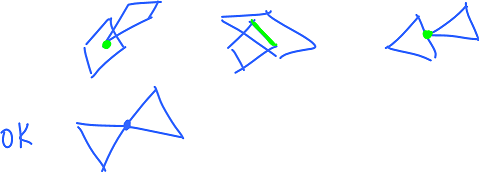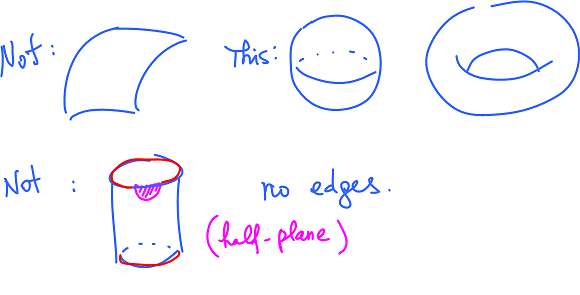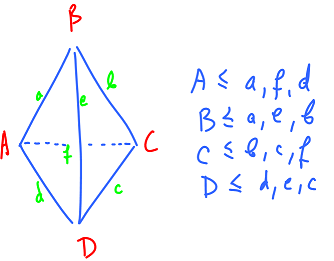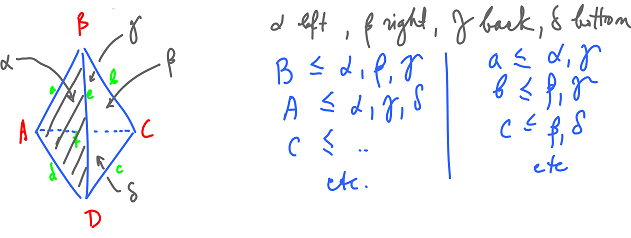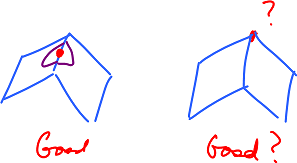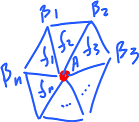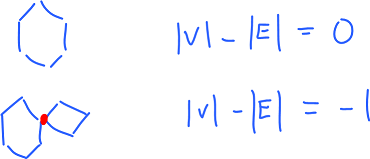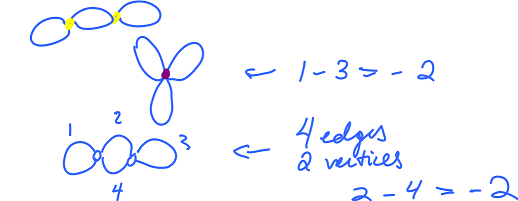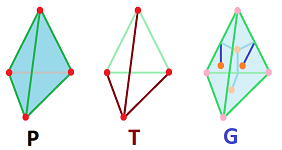This site is being phased out.
Polyhedron
Polyhedra are unions of polygons (faces) attached to each other along the edges.
Next we want the polyhedron to look like a surface, for the Euler's theorem.
In common: locally look like a plane!
Should be familiar! Curves locally look like a straight line.
How do we ensure That our polyhedron is a surface?
Find conditions on the polygons that make up the polyhedron that ensure that this is a surface.
Start: every vertex $V$ should be surrounded by faces.
What is a polyhedron for the Euler's theorem? We need a combinatorial description!
A polyhedron is made of these pieces:
- vertices -- set $V$ -- endpoints of...
- edges -- set $E$ -- boundaries of...
- faces -- set $F$.
Example.
We set up a partial order: $$A < a,c;B < a,b;C<c,b;$$ $$a,b,c < \alpha.$$ It is about the boundary relation: $x<y$ if $x$ is a part of the boundary of $y$.
Example. A wire-frame:
Take this, we can reconstruct the polyhedron.
What about the sphere/surface?
Rule 1: Every edge is contained in exactly two faces.
Combinatorially: for each $e \in E$ there exist exactly two (distinct) $\alpha,\beta \in F$ such that $e,\alpha,e<\beta$.
With this condition, does this have to be surface?
ex: just a point, no edges
So, one edge -- two faces etc.
Requirement:
- edges intersect by vertices,
- faces intersect by edges.
Definition of surface = every point has a neighborhood homeomorphic to the the disk.
Rule 1 ensured that this is true for every point inside an edge:
Exercise. Find an example: Rule 1 but not a surface.
Now vertices...
Rule 2: Every vertex is "surrounded" by faces.
Given $A \in V$, there are $f_1,..., f_n$ such that $$A<f_1,..., f_n$$ and there are $B_1,..., B_n \in V$, such that $$B_n = B_0$$ and $$AB_k < f_k,f_{k+1} ({\rm mod} n).$$
Next, the sphere as a specific surface...
- 1: It's connected!
To be precise it "path-connected": Any 2 points can be connected by a path.
Two vertices.... a path made of edges.
Translate: Given two vertices $A, B \in V$, $A \ne B$, there are $C_1,...,C_n \in V$ such that
- $AC_1 \in E,$
- $C_1C_2 \in E,$
- ...
- $C_nB \in E.$
This is "edge path-connectedness".
Path-connectedness: in a topological space $X$, for any two points $A, B \in X$, three is a cont. function
- $f:[0,1] \to X$ such that $f(0)=A,f(1)=B$.
Note the difference:
- Looser: only vertices have to be connected.
- Tighter: you have to use edges for the path.
Proposition. Path-connectedness <=> edge path connectedness (for polyhedra).
Exercise. idea: face at a time.
Second, how do we exclude the torus?
Does any loop divides it into two pieces?
A loop is a closed path, should be made of edges.
A path is
- a sequence of edges $a_1,...,a_n \in E$,
- a sequence of vertices $A_1,...,A_{n+1} \in V$,
such that $a_k= A_k A_{K+1}$.
If, in addition, $A_1 = A_{n+1}$, then the path is called a loop.
"Two pieces" = disjoint = not path connected = there is no path between some points.
Euler's Theorem. P is a polyhedron w/ $V, E, F$. Assume
- $P$ is path connected;
- Every loop cuts $P$ into two disjoint pieces.
Then $$|V|-|E|+|F|=2.$$
Let explore first.
How? Consider analogue for dimension $1$.
It's "polygon" instead! Or it can be described as a graph:
Theorem. $G$ is a graph,
- $G$ is path connected;
- $G - A$ is path connected, A is a vertex;
- every vertex is an end-point of exactly two edges (two edges share 2 or 0 vertices).
Then $$|V|-|E|=0.$$
Proof.
There is a path in $P - e$ between $A$ and $B$, and
- number of edges = number of vertices - 1.
Remains: show there are no other vertices or edges (exercise). $\blacksquare$
Exercise. Look at the details.
Exercise. What about trees?
More on graphs, topologically...
What it there are self-intersections?
Circle and figure eight:
Let's describe first... Conditions 1 and 2 are satisfied and 3 too except for one special vertex. This vertex separates the graph into 2 parts.
They are different! But what's in common?
- Loops: 1 loop, 2 loops, 3 loops
- Euler characteristic: 0, -1, -2.
So, the answer is topology. For more see Euler-Poincare formula
Euler's theorem again.
Idea of proof: build two graphs on the polyhedron $P$.
- $T$ captures all vertices of P and some edges.
- $\Gamma$ captures all faces of $P$ and the rest of the edges.
Now, this what we know:
- $V_T-E_T=1$
- $V_{\Gamma}-E_{\Gamma}=1$
Add them:
- $V_T-(E_T+E_{\Gamma})+V_{\Gamma}=2$
These three terms are
- vertices + edges = faces
of $P$. And the theorem follows.
We need $T$ and $\Gamma$ satisfying 1 and 2.
Lemma. Every graph has a subgraph which
- contains all of the original vertices and
- is a tree.
Start w/ the $1$-skeleton of $P$, which is a graph $G$ (edges). Then, by lemma, find a subgraph $T$ which is a tree, w/ vertices = vertices of $P$.
Idea of $\Gamma$, the dual graph of $T$. Then
- $T$ is connected -- check
- $T$ is a tree.
It is defined as follows:
- $\Gamma$'s vertices are "middle points" of the faces.
- $\Gamma$'s edges connect $\Gamma$'s vertices by crossing the edges of $P$, but not one's of $T$.
1) It is always possible to get from one face to any adjacent face w/o crossing $T$. Why?
Otherwise the two faces would be separated by a loop of $T$, not possible, as there are no loops in $T$.
2) T is a tree. Why?
If there is a loop in, the loop would separate $P$ into 2 pieces, which contradicts condition 2.
